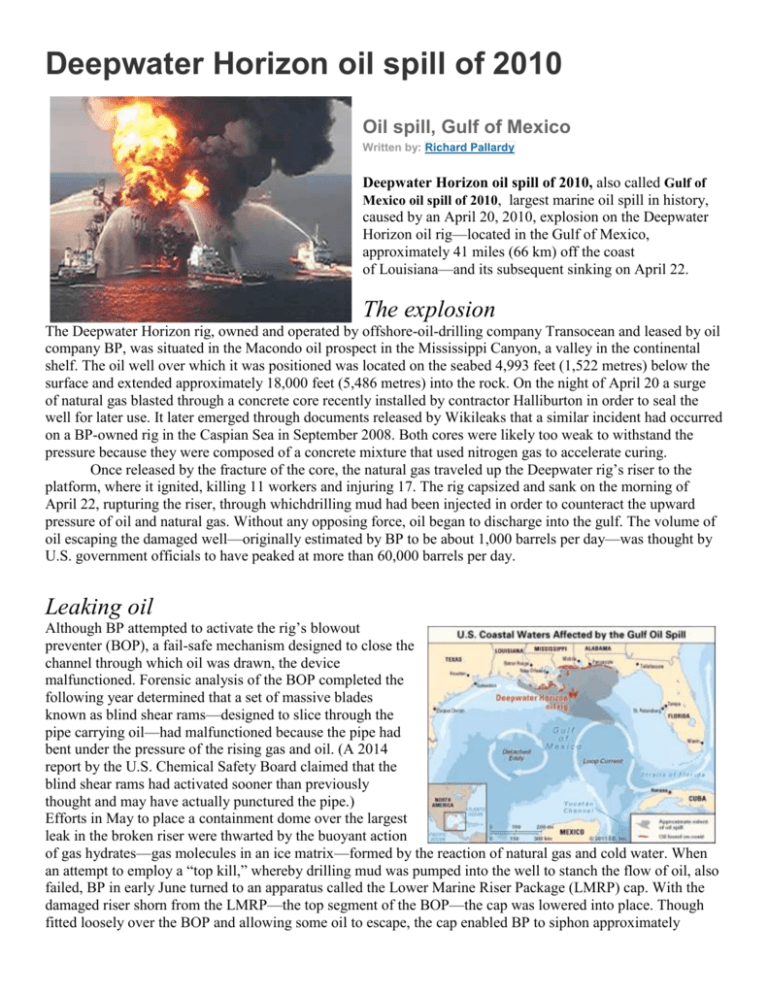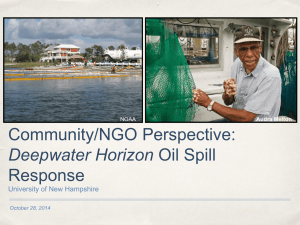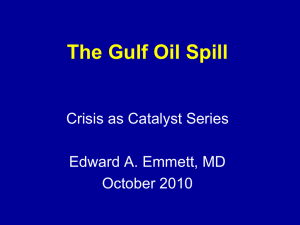"Deepwater Horizon oil spill of 2010". Encyclopædia Britannica
advertisement

Deepwater Horizon oil spill of 2010 Oil spill, Gulf of Mexico Written by: Richard Pallardy Deepwater Horizon oil spill of 2010, also called Gulf of Mexico oil spill of 2010, largest marine oil spill in history, caused by an April 20, 2010, explosion on the Deepwater Horizon oil rig—located in the Gulf of Mexico, approximately 41 miles (66 km) off the coast of Louisiana—and its subsequent sinking on April 22. The explosion The Deepwater Horizon rig, owned and operated by offshore-oil-drilling company Transocean and leased by oil company BP, was situated in the Macondo oil prospect in the Mississippi Canyon, a valley in the continental shelf. The oil well over which it was positioned was located on the seabed 4,993 feet (1,522 metres) below the surface and extended approximately 18,000 feet (5,486 metres) into the rock. On the night of April 20 a surge of natural gas blasted through a concrete core recently installed by contractor Halliburton in order to seal the well for later use. It later emerged through documents released by Wikileaks that a similar incident had occurred on a BP-owned rig in the Caspian Sea in September 2008. Both cores were likely too weak to withstand the pressure because they were composed of a concrete mixture that used nitrogen gas to accelerate curing. Once released by the fracture of the core, the natural gas traveled up the Deepwater rig’s riser to the platform, where it ignited, killing 11 workers and injuring 17. The rig capsized and sank on the morning of April 22, rupturing the riser, through whichdrilling mud had been injected in order to counteract the upward pressure of oil and natural gas. Without any opposing force, oil began to discharge into the gulf. The volume of oil escaping the damaged well—originally estimated by BP to be about 1,000 barrels per day—was thought by U.S. government officials to have peaked at more than 60,000 barrels per day. Leaking oil Although BP attempted to activate the rig’s blowout preventer (BOP), a fail-safe mechanism designed to close the channel through which oil was drawn, the device malfunctioned. Forensic analysis of the BOP completed the following year determined that a set of massive blades known as blind shear rams—designed to slice through the pipe carrying oil—had malfunctioned because the pipe had bent under the pressure of the rising gas and oil. (A 2014 report by the U.S. Chemical Safety Board claimed that the blind shear rams had activated sooner than previously thought and may have actually punctured the pipe.) Efforts in May to place a containment dome over the largest leak in the broken riser were thwarted by the buoyant action of gas hydrates—gas molecules in an ice matrix—formed by the reaction of natural gas and cold water. When an attempt to employ a “top kill,” whereby drilling mud was pumped into the well to stanch the flow of oil, also failed, BP in early June turned to an apparatus called the Lower Marine Riser Package (LMRP) cap. With the damaged riser shorn from the LMRP—the top segment of the BOP—the cap was lowered into place. Though fitted loosely over the BOP and allowing some oil to escape, the cap enabled BP to siphon approximately 15,000 barrels of oil per day to a tanker. The addition of an ancillary collection system comprising several devices, also tapped into the BOP, increased the collection rate to approximately 25,000 barrels of oil a day. In early July the LMRP cap was removed for several days so that a more permanent seal could be installed; this capping stack was in place by July 12. Though the leak had slowed, it was estimated by a governmentcommissioned panel of scientists that 4.9 million barrels of oil had already leaked into the gulf. Only about 800,000 barrels had been captured. On August 3 BP conducted a “static kill,” a procedure in which drilling mud was pumped into the well through the BOP. Though similar to the failed top kill, mud could be injected at much lower pressures during the static kill because of the stabilizing influence of the capping stack. The defective BOP and the capping stack were removed in early September and replaced by a functioning BOP. The success of these procedures cleared the way for a “bottom kill,” considered to be the most likely means of permanently sealing the leak. This entailed pumping cement through a channel—known as a relief well—that paralleled and eventually intersected the original well. Construction of two such wells had begun in May. On September 17 the bottom kill maneuver was successfully executed through the first relief well. The second had been intended to serve as a backup and was not completed. Two days later, following a series of pressure tests, it was announced that the well was completely sealed. Claims by several research groups that subsurface plumes of dispersed hydrocarbons had been detected in May were initially dismissed by BP and the National Oceanic and Atmospheric Administration (NOAA). However, it was verified in June that the plumes were in fact from the Deepwater spill. The effect of the microscopic oil droplets on the ecosystem was unknown, though their presence, along with that of a layer of oil several inches thick discovered on portions of the seafloor in September, cast doubt on earlier predictions about the speed with which the discharged oil would dissipate. Bacteria that had adapted to consuming naturally occurring gas and oil seeping from the seabed were thought to have consumed a portion of it. Cleanup efforts The petroleum that had leaked from the well before it was sealed formed a slick extending over thousands of square miles of the Gulf of Mexico. To clean oil from the open water, 1.8 million gallons of dispersants— substances that emulsified the oil, thus allowing for easier metabolism by bacteria—were pumped directly into the leak and applied aerially to the slick. Booms to corral portions of the slick were deployed, and the contained oil was then siphoned off or burned. As oil began to contaminate Louisiana beaches in May, it was manually removed; more difficult to clean were the state’s marshes and estuaries, where the topography was knit together by delicate plant life. By June, oil and tar balls had made landfall on the beaches of Mississippi, Alabama, and Florida. In all, an estimated 1,100 miles (1,770 km) of shoreline were polluted. The various cleanup efforts were coordinated by the National Response Team, a group of government agencies headed by the U.S. Coast Guard and the Environmental Protection Agency (EPA). BP, Transocean, and several other companies were held liable for the billions of dollars in costs accrued. Coast Guard cleanup patrols ultimately drew to a close in Alabama, Florida, and Mississippi in June 2013 and in Louisiana in April 2014. Aftermath and impact Economic prospects in the Gulf Coast states were dire, as the spill affected many of the industries upon which residents depended. More than a third of federal waters in the gulf were closed to fishing at the peak of the spill, due to fears of contamination. A moratorium on offshore drilling, enacted by U.S. Pres. Barack Obama’s administration despite a district court reversal, left an estimated 8,000–12,000 temporarily unemployed. Few travelers were willing to face the prospect of petroleum-sullied beaches, leaving those dependent on tourism struggling to supplement their incomes. Following demands by Obama, BP created a $20 billion compensation fund for those affected by the spill. A year later nearly a third of the fund had been paid out, though lack of oversight allowed government entities to submit wildly inflated claims, some unrelated to the spill. By 2013 the fund was largely depleted. Recovery was incremental. As oil dispersed, portions of the gulf began reopening to fishing in July, and by October the majority of the closed areas were judged safe. State governments struggled to draw attention to unsoiled or newly scrubbed beaches with advertising campaigns, often drawing on funds from BP. Oil continued to wash ashore in many areas, and much of it could not be removed, either because of logistical reasons—mats of submerged oil and organic matter collected in tidal zones that were difficult to reach—or because cleaning it up would inflict greater harm on the ecosystem. The drilling moratorium, initially set to expire in November 2010, was lifted in mid-October, though new drilling permits were not issued until February of the subsequent year following mounting government and industry pressure to increase domestic oil production. The emergence of BP chief executive Tony Hayward as the public face of the oil giant further inflamed public sentiment against the embattled company. The Englishman—who at one point remarked, “I’d like my life back”—was derided for his alternately flippant and obfuscating responses in media interviews and while testifying before the U.S. Congress. He was replaced in October. By the next year, the company had lost almost a quarter of its market value and had hemorrhaged over $40 billion in costs associated with cleanup and recovery. The National Commission on the BP Deepwater Horizon Oil Spill and Offshore Drilling, formed by Obama in May 2010, faulted the Obama administration’s response to the spill in a report issued in October. In December the Justice Department sued BP, along with other companies involved in the disaster, in New Orleans civil court. The commission’s final report, issued in January 2011, attributed the spill to a lack of regulatory oversight by the government and negligence and time-saving measures on the part of BP and its partners. A report released in September by the Joint Investigation Team of the Bureau of Ocean Energy Management, Regulation and Enforcement (BOEMRE) and the U.S. Coast Guard emphasized BP’s ultimate responsibility for the disaster. (BOEMRE had supplanted the Minerals Management Agency, which had regulated drilling before the spill, in June 2010.) The report noted that, although the defective concrete cap had been installed by Halliburton, decisions about the installation process made by BP had been the cause of the failure. The investigation further found that BP and Transocean employees aboard the rig had—while engaged in testing procedures—ignored early indications of a problem and thus missed opportunities to prevent a fullscale blowout. Though representatives of BP conceded that the company was responsible for some of the factors contributing to the spill, they stressed that their partner companies were also to blame. Halliburton and Transocean similarly pointed to failures on the part of the other parties involved. Environmental costs Thousands of birds, mammals, and sea turtles were plastered with leaked oil. There was speculation that a spike in cetacean strandings and deaths that was recorded by NOAA beginning in February 2010 was further exacerbated by the spill. Typical causes of such widespread fatalities, including morbillivirus and toxins from red tides, were ruled out, and there was an unusual incidence of Brucellainfection in stranded dolphins, leading researchers to suspect that contaminants from the spill had made cetaceans more vulnerable to other environmental dangers. A December 2013 study of living dolphins in Barataria Bay, Louisiana, found that roughly half were extremely sick; many suffered from lung and adrenal disorders known to be linked to oil exposure. Some 1,100 whales and dolphins had been found stranded by 2015, a figure representing only a tiny percentage of the animals affected. Birds were particularly vulnerable to the oil’s effects, and many perished—from ingesting oil as they tried to clean themselves or because the substance interfered with their ability to regulate their body temperatures. The brown pelican, recently delisted as an endangered species, was among the species most affected. A 2014 study projected that perhaps 12 percent of the brown pelicans and more than 30 percent of the laughing gulls in the area hit by the spill had been wiped out. Even individuals not directly contaminated by oil were affected. A 2012 study determined that white pelicans that had migrated from the gulf to Minnesota to breed were producing eggs that contained discernible amounts of compounds that were traceable to the BP spill. Eggs containing traces of contaminants were found in Iowa and Illinois as well. Animals that were found alive in the wake of the spill were transported to rehabilitation centres and, after being cleaned and medically evaluated, were released in oil-free areas. Concerns about the offspring of sea turtles that nested on the gulf coasts of Alabama and Florida led wildlife officials to dig up thousands of eggs and hatch them in a warehouse for later release on the Atlantic coast. By late 2012 some 1,700 turtles had been found dead. A long-term satellite tracking study released in May 2013 showed that the endangered Kemp’s ridley sea turtle was likely severely affected, as its preferred foraging territory was within the area damaged by the spill. It was estimated that up to 65,000 imperiled turtles had died during 2010 alone, mostly as a result of oil contamination. The impacts on smaller species were more difficult to determine. Numerous species of fish and invertebrates spawned in the gulf, and it was thought likely that some would succumb to the toxic effects of the oil. A 2014 study showed that the larvae of commercially important fish species, including tuna, likely developed heart defects after exposure to polycyclic aromatic hydrocarbons (PAHs) from the oil. Areas of the seabed that had been coated by by-products of bacteria were essentially dead zones; many sedentary organisms had suffocated or been sickened by the material, and most mobile organisms had fled. Reefs outside a 12-mile (19-km) radius from the Deepwater well appeared largely unaffected, but those within were heavily stressed. Laboratory studies suggested that oil and dispersants made coral reproduction more difficult. Coral larvae, which are initially mobile, attached to mature corals at much-reduced rates following exposure to the substances. Tests also determined that oil and dispersants were fatal to rotifers, microorganisms crucial to the gulf food web. An April 2014 mission conducted by the research group Ecosystem Impacts of Oil and Gas Inputs to the Gulf(ECOGIG) aboard the submersible Alvin—which had famously been involved in investigating the wreckage of the Titanic—noted some ecological recovery of oiled areas of the seafloor, though detectable oil levels in sediment cores remained the same as they had been four years earlier. "Deepwater Horizon oil spill of 2010". Encyclopædia Britannica. Encyclopædia Britannica Online. Encyclopædia Britannica Inc., 2015. Web. 15 Oct. 2015 .






